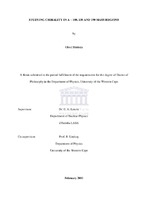| dc.contributor.advisor | Lawrie, E. A. | |
| dc.contributor.advisor | Lindsay, R. | |
| dc.contributor.author | Shirinda, Obed | |
| dc.contributor.other | Dept. of Physics | |
| dc.contributor.other | Faculty of Science | |
| dc.date.accessioned | 2013-08-02T14:11:04Z | |
| dc.date.available | 2011/10/20 09:38 | |
| dc.date.available | 2011/10/20 | |
| dc.date.available | 2013-08-02T14:11:04Z | |
| dc.date.issued | 2011 | |
| dc.identifier.uri | http://hdl.handle.net/11394/1792 | |
| dc.description | Philosophiae Doctor - PhD | en_US |
| dc.description.abstract | Chirality is a nuclear symmetry which is suggested to occur in nuclei when the total angular momentum of the system has an aplanar orientation [Fra97, Fra01]. It can occur for nuclei with triaxial shape, which have valence protons and neutrons with predominantly particle and hole nature. It is expected that the angular momenta of an odd particle and an odd hole (both occupying high-j orbitals) are aligned predominantly along the short and the long axes of the nucleus respectively, whereas the collective rotation occurs predominantly around the intermediate axis of a triaxially deformed nucleus in order to minimize the total energy of the system. Such symmetry is expected to be exhibited by a pair of degenerate DI = 1 rotational bands, i.e. all properties of the partner bands should be identical. The results suggested that spin independence of the energy staggering parameter S(I ) within two-quasiparticle chiral bands (previously suggested a fingerprint of chirality) is found only if the Coriolis interaction can be completely neglected. However, if the configuration is nonrestricted, the Coriolis interaction is often strong enough to create considerable energy staggering. It was also found that staggering in the intra- and inter-band B(M1) reduced transition probabilities (proposed as another fingerprint of chirality) may be a result of effects other than strongly broken chirality. Therefore, the use of the B(M1) staggering as a fingerprint of strongly broken chiral symmetry seems rather risky, in particular if the phase of the staggering is not checked. | en_US |
| dc.language.iso | en | en_US |
| dc.publisher | University of the Western Cape | en_US |
| dc.subject | Quasiparticle-hole configuration; Degenerate DI = 1 rotational band; Excitation energies; Alignment; Angular momenta; Electromagnetic transitions; B(M1) staggering; Aplanar rotation; Chirality; • Two-quasiparticle-plus-triaxial-rotor model. | en_US |
| dc.subject | Quasiparticle-hole configuration | en_US |
| dc.subject | Degenerate DI = 1 rotational band | en_US |
| dc.subject | Excitation energies | en_US |
| dc.subject | Alignment | en_US |
| dc.subject | Angular momenta | en_US |
| dc.subject | Electromagnetic transitions | en_US |
| dc.subject | B(M1) staggering | en_US |
| dc.subject | Aplanar rotation | en_US |
| dc.subject | Chirality | en_US |
| dc.subject | Two-quasiparticle-plus-triaxial-rotor model | en_US |
| dc.title | Studying chirality in a ~ 100, 130 and 190 mass regions | en_US |
| dc.type | Thesis | en_US |
| dc.rights.holder | University of the Western Cape | en_US |
| dc.description.country | South Africa | |

